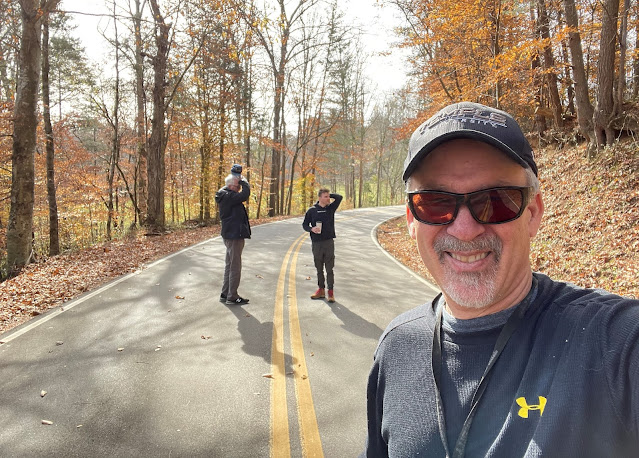 |
Pals Jack Richards, Taylor Agan and I enjoyed an epic visit to the Battle of Dug Hill site.
(CLICK ON IMAGES TO ENLARGE.) |
Like this blog on Facebook | Follow me on Twitter
On the afternoon of Feb. 22, 1864, guerrillas ambushed Union cavalry on a desolate mountain road above the Calfkiller River, near Sparta, Tenn. On Saturday, we visited the unmarked site of the small but brutal Battle of Dug Hill with the Taylor Agan, a descendant of a soldier who may have fought here. Appearing in the background above are my puzzled friends,
renowned hypnotist Jack Richards and Agan, a talented songwriter. ...
... and here’s the Calfkiller, named for either a large ant or calves that drowned during a flood—that's what a local fisherman told me—or a Cherokee chief. Must confirm. The site 95 miles east of Nashville is so remote it conjured up images of this
1972 survival thriller. 😄
On a serpentine, two-lane mountain road en route to the obscure hallowed ground, Richards and I contemplated farewell messages to our families as we gazed into the deep abyss to our right.
"Hey, look, no guardrail!" Note of interest: Locals hunt for
ginseng in these hills! ...
When I heard “Battle of Dug Hill” for the first time recently, the magnificent voice of David McCullough, narrator for the Ken Burns'
Civil War doc, popped into my head:
“The Civil War was fought in 10,000 places, from Valverde, New Mexico, and Tullahoma, Tennessee, to St. Albans, Vermont, and Fernandina on the Florida coast. ...
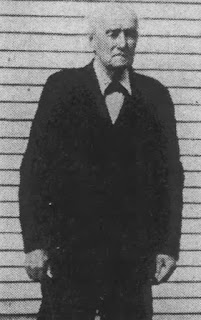 |
Rebel vet Wiley Steakley:
"We finally put the Yankees
on the run."
|
... On Feb. 22, 1864, John W. Clark, a private in the 1st Tennessee Mounted Infantry riding with the 5th Tennessee Cavalry, advanced up the mountain road with two comrades. They were the tip of the cavalry's spear.
Then, about 100 yards away, Clark spotted two Rebs astride their horses—bait to lure the Yankees into a death trap. In an account published in The National Tribune, a veterans' newspaper, Clark recalled what happened next:
"I sounded the double quick charge signal, and lit out after them, and about the time the company caught up we spied two lines of battle formed. One line was up to our right on high ground about 300 feet above us. We were in the Dug Hill road, which ranged around the mountain about 600 yards from where we entered it. At the loose end of a thin hill was another line of battle. By this time another line had formed behind us, and the johnnies were cross-firing on us three ways."
Dozens of Yankees tumbled from their saddles. "The smoke was so dense," Clark remembered, "that you could not tell one man from the other."
Decades after the battle, Wiley Steakley—one of the guerrillas who set the trap—said Dug Hill was one of the hardest-fought battles. "We finally put the Yankees on the run," he said as he prepared for his 96th birthday in 1940.

... In the ambush, the 5th Tennessee Cavalry lost at least 21 soldiers killed out of roughly 100 engaged. The Rebels—perhaps 40 or more under notorious guerrilla leader Champ Ferguson—suffered far fewer, if any.
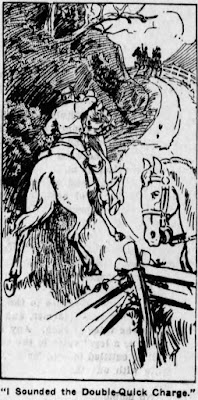 |
An illustration of the
Battle of Dug Hill,
published in the Alva Weekly
(Okla.) Record in 1911. |
Well into the fight, a Rebel bullet passed so close to Clark's head that it left a blister across his forehead. "Just after that another cut my bridle reins in two between my hand and my horse's neck," he recalled. "We were all close together, and we started almost straight up the mountain."
As Clark attempted to escape on the rugged ground, a Rebel grabbed the tail of his horse. "I didn't have a lead in either of my navies [revolvers] and as I was a bugler I wasn't supposed to carry a gun," Clark remembered. "I drew my sword and gave a right-hand back cut, and I was free from him."
Many Federal fallen were shot in head. Showing no mercy, guerrillas murdered some U.S. Army horsemen after they surrendered,
according to accounts, and Yankees vowed revenge.
... Shelton Harris, a 21-year-old private in Company I of the 5th Tennessee Cavalry, was killed by a "gunshot wound which entered his right side causing instant death"—perhaps fired from these woods. (Evidence of the fight occasionally surfaces—a local told us his wife found a Confederate button metal detecting on ground near the mountain road.) Private Harris was the unmarried son of 50-year-old Ruth Harris of Liberty, Tenn. ...
... More than a year after Shelton's death, Ruth filed for a dependent's pension. The family circumstances were difficult. Harris' husband had abandoned the family and "never so much as furnished [Shelton] means enough to buy him a Linnon (sic) cap," according to this pension file affidavit. "He left the country when my son was but one or two months old and never has saw him since." Added Ruth: "My son was a Basterd (sic) child and never knew his father." Harris' pension claim was approved at the standard rate of $8 a month. Shelton's final resting place is unknown.

... Perhaps this is the view guerrillas had from the wooded mountainside as they whacked the Federals. Agan's research indicates this is the battle site; other alternatives have been offered. Wherever this fight occurred, it was like "like shooting fishing in a barrel," said Agan, whose great-great-great-great-grandfather John Parker served in the 5th Tennessee Cavalry. (The 23-year-old was listed as present on the rolls of the regiment that day, but's it's unclear if he fought at Dug Hill.) More on Private Parker of Company K of the 5th Tennessee Cavalry in a bit ...

... A few 5th Tennessee Cavalry soldiers escaped along the Calfkiller to Sparta, roughly nine miles distant. One U.S. Army horsemen hid in a hollow log until the coast was clear.
"[I]f one could forget the horror of it, it was one of the most ridiculous battles ever fought," the
Rebel fighter recalled. "Why, the [U.S. Army] boys just sat upon their horses and waited to be knocked off. ... several were captured while trying to make their way to Sparta, hatless and shoeless. It was a funny fight if ever a fight was funny. I never saw one like it, and have no wish to see another.”
... the next day, guerrillas—attired in Federal uniforms as a ruse—killed four 5th Tennessee Cavalry soldiers on picket duty near Sparta. Private Elijah Crabtree, a 29-year-old private in Company G, was among them. On Feb. 24, 1864, his captain wrote this condolence note to his widow, Ezzy. "It becomes my painful duty," it begins, "to announce to you intelligence which will cause your soul to wither(?) in anguish..." Adds the officer: "We all mourn his loss deeply for not only was he a gallant soldier but a kind friend and companion."
... by the way, here's Champ Ferguson's grave in France Cemetery, near the Battle of Dug Hill site. He was hanged by the U.S. Army on Oct. 20, 1865, in Nashville after his conviction on 53 counts of murder of Federal soldiers—among them were U.S. Colored Troops at Saltville, Va. "I believe I was right in all I did," he said at his execution.
... some strange soul(s) plopped a couple brews next to Ferguson's gravestone, perhaps for Champ to enjoy in hell. ...
... while others placed coins atop his gravestone. We spotted several pennies, Lincoln side up. Karma. ...
... Eager for grub and a chance to expand our minds, we too advanced on Sparta—home of bluegrass legend
Lester Flatts, who died in 1979 ...
... At Sparta, we met Peggie Hurteau, a docent at the excellent White County Heritage Museum. Here we examined Battle of Dug Hill docs, a slice of the tree where
Felix Zollicoffer was shot at the Battle of Mill Springs (Ky.), a small bottle of dirt from Parker's Crossroads, a rotary phone, Rebel General George Dibrell's 1851 Colt pistol, and this detailed model of Sparta that took a local couple 750 hours to complete. (You don't get this stuff on any other Civil War blog.) The hot-air balloon represents the ballooonist who crashed in the woods near Sparta in 1927. (Note to Civil War travelers: Always ask the locals where to eat. Peggie recommended
Yanni's Grille. Meal tasted especially great because hypnotist Richards picked up check.) ...
... However, my personal highlight in the museum was this farmer carved from a tree.
... But back to the Battle of Dug Hill and John Parker, the blue-eyed, fair-haired farmer from DeKalb County, Tenn. Months ago, Agan—a remarkable sleuth who has 12 direct, verified Civil War ancestors (five Union, seven Confederate)—discovered his great-great-great-great grandfather
Parker's grave in a rural Tennessee farm cemetery, a 40-minute drive from the Battle of Dug Hill site. His GGGG-grandmother was buried next to him. About to give up his search that day, Agan consulted with a higher power: "Lord, where are those graves?" he said. Then he brushed aside a pile of leaves ... and the rest is
history. Fabulous.
... Not even these mad cows could ruin this day.
OK, lots more digging for me to do on the Battle of Dug Hill. On deck: A search of pension records and a deep dive into
newspapers.com. Have more on this obscure fight? Shoot me a note.
Let's keep history alive. 👍👍
-- Have something to add (or correct) in this post? Email me here.
SOURCES
- Chattanooga (Tenn.) Daily Times, Feb. 23, 1940.
- Dromgoole, Will Allen, The Sunny Side of the Cumberland, Philadelphia: J.B. Lippincott Company, 1886.
- Elijah Crabtree and Shelton Harris pension files, National Archives via fold3.com, Washington, D.C., WC71261 and WC99898.
- Nashville Banner, Nov. 30, 1912.
- Nashville Daily Union, March 15, 1864.
- Seals, Monroe. A History of White County Tennessee
- The National Tribune, Jan. 19, 1911.







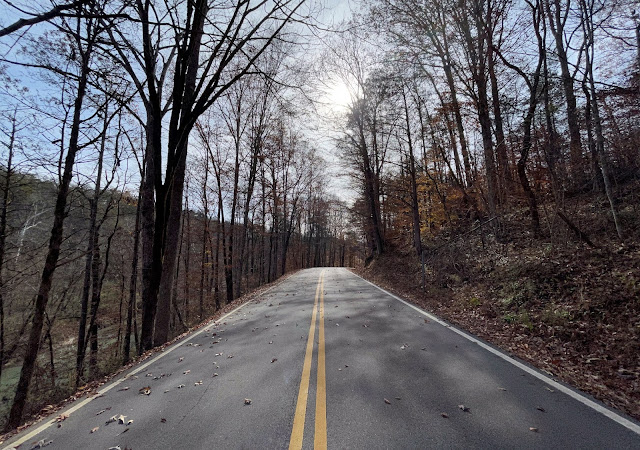







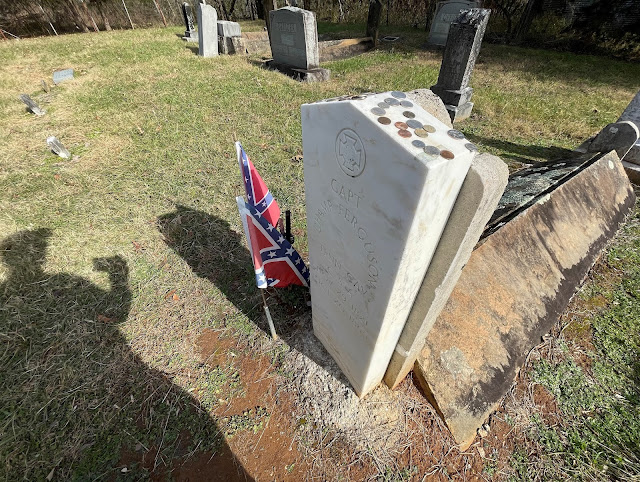



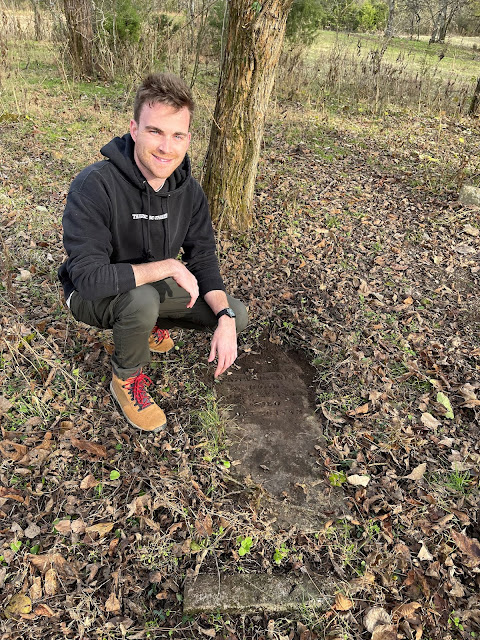

G'Day John,
ReplyDeleteThanks again for shedding light on another, more obscure,but just as deadly battle of the American Civil War. Rob FNQ,Au
Why do you wish hell upon that man's soul. In the face of a tyrannical government and with his family and friends being killed he stood up and fought. Hell is a place for cowards not for men who fight tyrants. And you do realize Champ has many descendants in the area and I bet not one of them has ever visited your great great grandfather's grave and wish his soul to hell.
ReplyDeletethank you for this comment. Was enjoying the article till that garbage.
DeleteThank you, thank you MidTenAirBear. I couldn't have said it better than you did. I also agree with the other person who enjoyed this post up to the judgy - Champ in hell - part. Live through what he did and then let's see how nice you are, buddy. ??? Sounds like he'd already lived through a hell none of us will ever know before he did any of his "misdeeds".
DeleteChamp was a murderer, Anonymous. Please stop with the "can't judge by 21st century standards" bullshit.
DeleteJohn, Champ Ferguson was no better or worse than Union Guerrilla fighter Tinker Dave Beaty. They both were doing what they thought was right at the time.
DeleteI can only stand in amazement, to try to ponder the thought of both sides fighting each other, with large, single shot riffles, lead balls, bayonet' and cannons. I visited the Graves of both sides at Stone River , and it was quite sobering and sad. What a horrible war.
ReplyDeleteThanks for posting. I have seen a sign when driving through the area and have always wanted to check it out.
ReplyDelete